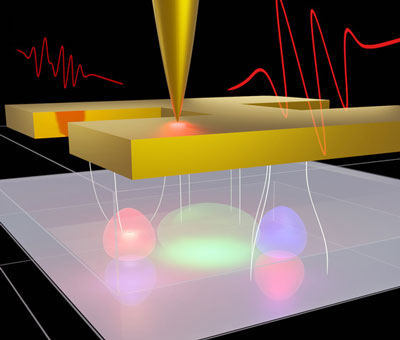| Jun 18, 2019 | |
Detecting intersubband polaritons in a single nanoantenna |
|
| (Nanowerk Spotlight) Electronic transitions between confined states within a quantum well – a thin semiconductor heterostructure that confines electrons to two-dimensional movement with distinct energy states – are widely used in optoelectronics. Familiar examples include quantum cascade lasers and quantum well infrared photodetectors, which can operate in a wide range of wavelengths, from the far- to near-infrared. | |
| Quantum wells are also attractive for fundamental studies because the coupling of the intersubband (ISB) electronic excitation (the electronic transition between the ground and the excited states in a doped semiconductor quantum well) to the electromagnetic field leads to significant modification of the electronic states and formation of polaritons. There is growing interest in studying this phenomenon because it may enable novel devices such as polariton lasers and because the physics of ISB polaritons is relatively unexplored. | |
| "In prior investigations, intersubband polaritons have been observed only in arrays of nanoantennae, which present additional challenges for analysis," says Dr. Oleg Mitrofanov from the University College London (UCL). "Our latest work demonstrates that it is possible to study polaritons in a single isolated nanoantenna. By probing evanescent fields on the nanoantenna surface, we observed a signature of polaritons formed underneath the antenna surface." | |
 |
|
| Illustration depicting nanoantenna coupling to intersubband electronic excitations in a quantum well underneath. Two intersubband polariton states are formed as a result light-matter coupling, and these states are observed using near-field spectroscopy of evanescent fields on the nanoantenna surface. (Image: Dr. Oleg Mitrofanov) | |
| Mitrofanov and his collaborators at the Center for Integrated Nanotechnologies have published their findings in Nano Letters ("Observation of Intersubband Polaritons in a Single Nanoantenna Using Nano-FTIR Spectroscopy"). | |
| The team observed, for the first time, formation of intersubband polaritons using only a single nanoantenna. Polaritons are coupled states involving a photon and matter excitation, in this case, an electronic excitation in a quantum well, which is one of the exemplary solid state systems exhibiting quantum mechanical behavior. | |
| For this work, the researchers employed a scattering-type scanning near-field optical microscope (s-SNOM) to enable ISB polariton studies in the single nanoantenna regime, using nanoscale Fourier-transform infrared (nano-FTIR) spectroscopy. | |
| "By analyzing evanescent fields on the surface of a nanoantenna fabricated on top of a stack of quantum wells, we detected splitting of the nanoantenna resonance into two polariton modes, upper and lower polaritons, indicative of strong coupling to the ISB transition in the quantum wells," Mitrofanov explains to Nanowerk. "The nano-FTIR approach opens doors to investigations of ISB polariton physics in the single nanoantenna regime, and it makes a step toward the goal of achieving the regime of a small number of excitations, in which the ISB polaritons were predicted to exhibit bosonic behavior and form a condensate." | |
| He adds that there is a spectrum of quantum effects, which have been predicted for the intersubband polaritons, but so far have been impossible to verify and investigate. "We anticipate that the near-field approach will lead to scientific discoveries and a better understanding of this system." | |
| The researchers are also interested in applications of this near-field technique to investigate light-matter coupling in other systems, involving different material excitations and different optical resonators. | |
| This approach also holds great potential for probing nanoscale quantum systems not only positioned on the surface but also buried within a depth of over 100 nm. For example, a small nonresonant nanoantenna may extend the reach of s-SNOM deeper below the surface and enable spectroscopy of ISB transitions in quantum wells without strong coupling. | |
| "We also foresee that the possibility to detect the optical phase of nanoantenna-ISB polariton states will aid in the development of practical applications where knowledge of the local phase is essential, for example, for infrared metasurfaces," Mitrofanov notes. | |
 By
Michael
Berger
– Michael is author of three books by the Royal Society of Chemistry:
Nano-Society: Pushing the Boundaries of Technology,
Nanotechnology: The Future is Tiny, and
Nanoengineering: The Skills and Tools Making Technology Invisible
Copyright ©
Nanowerk LLC
By
Michael
Berger
– Michael is author of three books by the Royal Society of Chemistry:
Nano-Society: Pushing the Boundaries of Technology,
Nanotechnology: The Future is Tiny, and
Nanoengineering: The Skills and Tools Making Technology Invisible
Copyright ©
Nanowerk LLC
|
|
|
Become a Spotlight guest author! Join our large and growing group of guest contributors. Have you just published a scientific paper or have other exciting developments to share with the nanotechnology community? Here is how to publish on nanowerk.com. |
|
